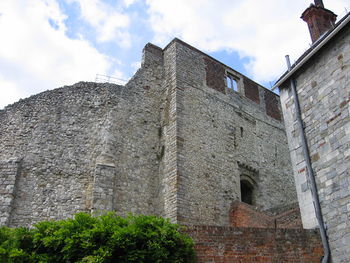Farnham Castle
Farnham Castle in Surrey was founded in the 12th century by Henry de Blois, the Bishop of Winchester. The castle was built on a ridge of chalk at the northern end of the town of Farnham. The town originated as a Saxon settlement and was greatly expanded in the 12th century, around the time Bishop Henry built the castle. Farnham Castle was originally a motte-and-bailey, with a square stone great tower standing on top of an earthen mound (the motte), surrounded by an enclosure (the bailey) containing ancillary buildings. The tower which now stands was a 12th-century replacement of the previous tower which was destroyed (slighted) by Henry II in 1155. A 320-acre deer park under the auspices of the castle and its lord was enclosed in the 12th century.[1]
The castle was the seat of the Bishops of Winchester until the early 20th century.[2] After the Second World War, care of Farnham Castle passed to the Ministry of Works (later succeeded by English Heritage). Soon after archaeological excavations began on the site.[3] Farnham Castle is both a Grade I listed building and a scheduled monument.[4][5]
References
- ↑ Robertson, Jane (2000). Extensive Urban Survey of Surrey: Farnham. Woking: Surrey County Archaeological Unit. pp. 5, 8–9.
- ↑ Robertson, Extensive Urban Survey of Surrey: Farnham, p. 9.
- ↑ Graham, David (October 2010). "Farnham Castle keep", Surrey Archaeological Society Bulletin 423. p. 2.
- ↑ "Farnham Castle", Pastscape. Accessed 10 March 2013.
- ↑ "Farnham Castle (comprising castle buildings to the south only)", The National Heritage List for England . Accessed 10 March 2013.
